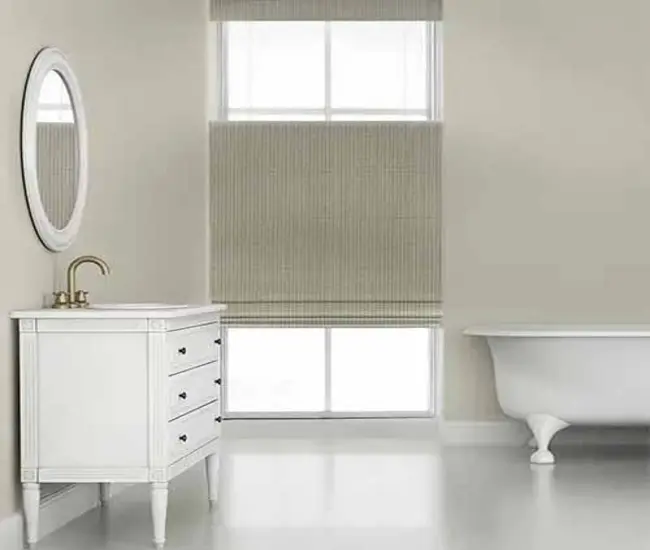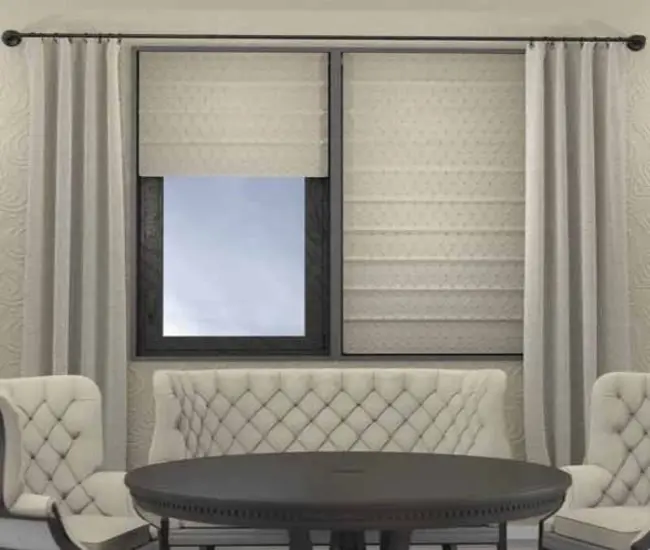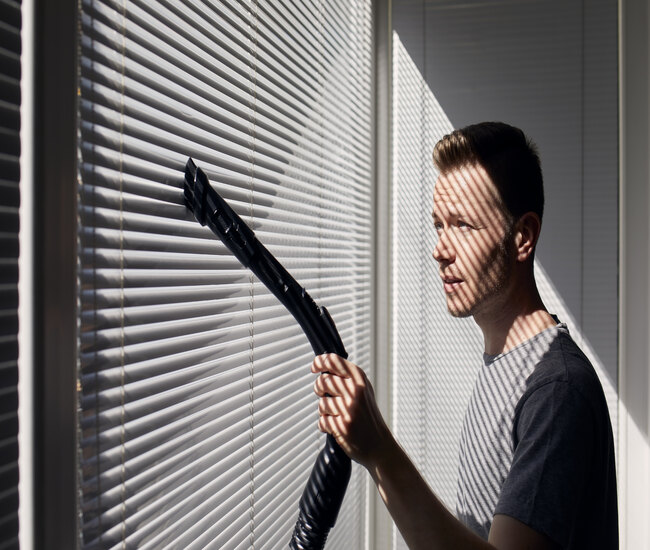What is the difference between Roman shades and blinds? Roman shades differ in both appearance and constructions from Roman blinds. While Roman shades look like a single piece of continous fabric, Roman blinds are made from a service of horizontal slats or panels.
Though the terms Roman shades and Roman blinds are often used interchangeably, these are two structurally and functionally distinct window coverings for homes, offices, and other spaces.
Also, there can be different material choices for window blinds and shades. While the fabric panel of roman shades is typically made of 100% cotton, 100% rayon, silk, or polyester, the horizontal slats of Roman blinds are usually constructed from wood, bamboo, vinyl, faux wood, or other materials.
When it comes to style, Roman blinds have limited slat designs and sizes, such as front slat, while Roman shades come with lots of design options, including soft fold, flat fold, plain classic fold, European relaxed fold, and top down bottom up.
Roman shades are usually a better option for living rooms, dining rooms, and bedrooms, as they offer better look, functionality, and durability in moisture-free environments. On the other hand, Roman blinds are better suited to the environments of bathrooms, kitchens, and laundry rooms.
Unsure which option is more suitable for your settings, Roman blinds or shades. Read on to learn some key differences between Roman blinds and Roman shades.
But before proceeding to dissimilarities between Roman blinds and shades, let’s shed a bit of light on similarities in the two main types of Roman window treatments.
Similarities b/w Roman Blinds and Roman Shades

Roman shades and blinds are popular window treatments used in homes, offices, and other residential and commercial buildings. Both types of window coverings are available in lots of different styles and other custom options.
- Both Roman blinds and shades are beautiful, classic window treatments.
- Provide light control, privacy, and insulation.
- Available with lots of lift options, including cordless and motorized.
- Both are easy to measure for and install.
What is the Difference between Roman Blinds and Roman Shades?
Below are some of the typical differences between Roman shades and Roman blinds.
Structural Difference
Structurally, Roman blinds have slats, strips, or straps that can be oriented horizontally or vertically. These slats or fabric vanes can be tilted or adjusted for the required amount of privacy and light control. If the slats are oriented horizontally, the blinds are called horizontal Roman blinds. On the other hand, if they have a vertical orientation, the blinds are termed as vertical Roman blinds.
Alternatively, Roman blinds may also involve a roller mechanism to raise, lower, or adjust the fabric.
Roman Shades, on the other hand, are made from a single piece of fabric material that is attached to a rod or headrail. The fabric panel of Roman shades folds or unfolds as you raise or lower your window treatments. When raised, the sheet of fabric folds up in an accordion style.
Appearance

Roman window blinds create a clean, crisp look when folded, and they neatly fold up when raised. On the other hand, Roman shades exude a softer and more relaxed look than Roman blinds. Also, they can have a bordered or cuffed top to add a decorative touch to your room’s interior décor style.
Material Choices

Roman shades can be made from different types of materials, including light and breathable cotton fabric, silk, rich and luxurious velvet, and patterned or textured materials. Also, these custom window treatments are available in expensive and luxurious fabrics.
Compared to Roman shades, Roman blinds have fewer material choices, such as wood and bamboo and synthetic materials, like polyester.
Functional Potentials
Both Roman blinds and Roman shades offer diverse functional potentials, including privacy, light control, light filtering, blackout, UV protection, and insulation.
These features make them energy efficient window treatments for your homes, offices, and other buildings.
Layering Option
When it comes to creating a layered look, Roman shades are a better choice. For example, you can layer a sheer Roman fabric with an opaque curtain for more versatile light control.
Mounting Options
Roman blinds are usually mounted on the wall outside the window frame. On the other hand, Roman shades offer both inside and outside mounting options. However, if you go for an inside mount, you should consider the depth of the window frame. In case of insufficient depth, you should go for an outside mounting option.
Operation
Both Roman blinds and Roman shades can be operated, i.e., raised, lowered, and adjusted, with the help of various lift mechanisms, such as cord, cordless, continuous loop, motorized, and smart home integrated lift systems.
Cleaning and Maintenance

Roman blinds are usually easier to clean with the help of a soft cloth. On the other hand, Roman shades may require deep cleaning and washing.
Similarly, Roman blinds involve low maintenance costs, while Roman shades have a high maintenance cost.
Affordability Factor

Usually, Roman blinds are considered more affordable window treatments than Roman shades. However, there are multiple factors that affect the affordability of window coverings, such as choice of material, quality, durability, style, and functional potential.
DIY Roman Shades vs Blinds
To make a DIY Roman shade, follow these steps:
Step 1: Measure your window’s width and height to get the right size fabric.
Step 2: Cut the fabric according to the measure and add 3 to 4 inches to both width and height for better coverage. If you want to go with an inside mount, don’t add extra length or width.
Step 3: Attach the mounting hardware and install your new DIY Roman shades.
To make DIY Roman shades, choose a slatted fabric or select separate slats and join them with a cord. The remaining steps will be the same as for Roman blinds.
FAQs
What is the downside to Roman shades?
One downside to Roman shades is that they do not last as long as other window treatment options. It is because the fabric they are made of can wear down when exposed to heat, moisture, or excessive use. Secondly, they are unsuitable for rooms that gather moisture, such as bathrooms, kitchens, and laundry rooms.
Are blinds or shades more stylish?
Shades are typically a more stylish option.
- More Styles: While blinds have limited designs, shades usually come in a more diverse variety of fabrics, patterns, and colors.

- More Customizable: Shades are much more customizable than blinds. Also, they’re available with lots of upgraded fabrics and fabric wrapped valances to cover the mounting hardware.
- Add Softness and Elegance: While blinds are hard window treatments, shades are soft window coverings that add an elegant style to any room.
What is the difference between Roman shades and zebra shades?
Roman shades are preferred for a luxurious look, while zebra shades are perfect for situations where you want to control the amount of light that enters the room, as they can be adjusted to let in more or less light.
The additional functionality of zebra shades comes from the adjustable stripes, which can be adjusted to filter light and provide varying degrees of privacy and light control, ranging from sheer and light filtering to room darkening and blackout.
Need More Help?
Still unsure which is a better option for your room, Roman shades or blinds? Contact our professionals using 24/7 live chat or give us a ring at (800) 863-6109 for expert advice and a custom solution.
